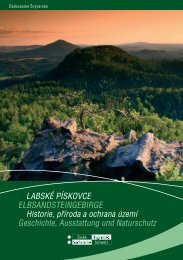ABSTRACT BOOK Sandstone Landscapes ... - Sandstones.org
ABSTRACT BOOK Sandstone Landscapes ... - Sandstones.org
ABSTRACT BOOK Sandstone Landscapes ... - Sandstones.org
You also want an ePaper? Increase the reach of your titles
YUMPU automatically turns print PDFs into web optimized ePapers that Google loves.
PZuzana VařilováBohemian Switzerland National Park Administration, Pražská 52, CZ-407 46 Krásná Lípa, CzechRepublic, and Institute of Geology, Academy of Sciences of the Czech Republic (z.varilova@npcs.cz)Geomorphology of the Bohemian Switzerland National Park, Czech RepublicBohemian Switzerland National Park constitutes an integral and unique geological and morphological unit,protecting an area of outstanding sandstone scenery. The main objects of protection are the so-called ‘rockcities’ developed in the sandstone, with their unique geomorphology, weathering features and relatedbiodiversity.<strong>Sandstone</strong> relief in such areas resulted from the combination of several basic genetic factors. Geological,and particularly tectonic, conditions decisively influenced the macrostructure of the terrain - e.g., by theformation of plateaus, valley networks and block disintegration of the sandstones. Lithological factors,assisted by selective weathering, participated in the formation of the sandstone pseudokarst landforms.Climatic/microclimatic factors defined the extent of capillary water transport to a considerable extent,being one of the most important causes of sandstone degradation. In the same way, biological factors - inparticular bioerosion - also contributed to the creation of various perforations and rock bowls. A leadingrole in the geomorphic history in this area was played by two main antagonistic processes: surfacehardening (rock crusts mostly caused by silica and ferruginous impregnation) and salt weathering.The high vertical relief of the National Park area was produced by intensive fluvial erosion at the end of theTertiary and during the Quaternary, which dissected the originally flat-topped sandstone massif. In thisprocess, less resistant rocks were removed and a wide spectrum of characteristic landforms was created.Large morphological forms (macroforms) include rock plateaus and canyons of the Kamenice and Křinicerivers, rock walls as high as 150 m (even 250 m in the area of the Pravčická brána Arch) and rock cities orrock labyrinths. Medium-sized forms (mesoforms) are represented by the renowned Pravčická brána RockArch. This structure, now the symbol of the National Park, originated due to lateral erosion of a narrowsandstone rib. Its dimensions (16 m in height, almost 27 m in length) make it the largest sandstone arch inEurope. Rock ledges, shelters and chimney rocks are also abundant. Rock pillars, mushroom rocks and rockwindows occur rarely. Smaller relief forms on the surface (microforms) are represented mainly by abundanthoneycombs, pits and rock cavities. Pseudokarst karren ca. 0.7 m deep often cover the rims of the plateausand cliffs.References:CÍLEK, V. (1998b): <strong>Sandstone</strong> phenomenon: antagonism between surface hardening and salt weathering. –In: Sulovský, P., Zeman, J. (eds.): Enviweath 96, Enviromental Aspects of Weathering Processes. –Masaryk University. Brno.GOUDIE, A., VILES, H. (1997): Salt Weathering Hazards. – John Wiley & Sons, Ltd. Chichester.VALEČKA, J. ed. (1997): České Švýcarsko. Geologická a přírodovědná mapa 1 : 25 000. CzechGeological Survey. Praha.VALEČKA, J. (2000): České Švýcarsko – Geologie národních parků České republiky (BohemianSwitzerland – Geology of National Parks in the Czech Republic). – Czech Geological Survey. Praha.VÍTEK, J. (1985): Classification of pseudokarst forms in Czechoslovakia. – Int. J. Speleol., 13. Roma.




